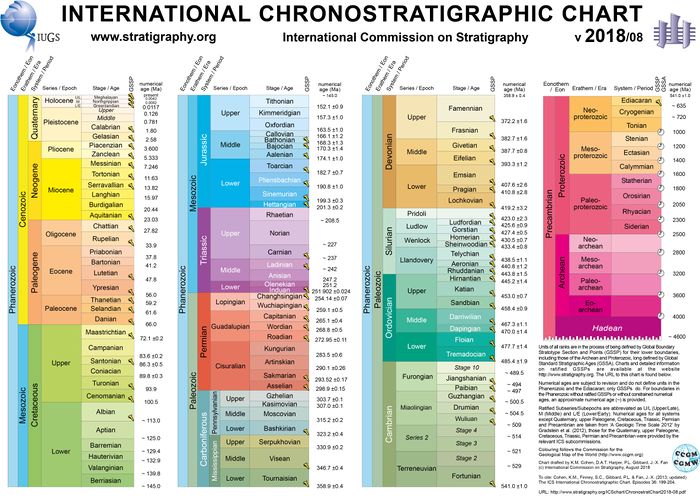Phanerozoic
The Phanerozoic is the current geological eon. It began approximately 541.0 million years ago. It is predated by the Precambrian eons.[1] The Phanerozoic began with the Cambrian Explosion, which was the massive biodiversification of multicellular organisms that developed in the late Precambrian. The Phanerozoic is divided into three eras: the Cenozoic or "Age of Recent Life"(current era), the Mesozoic or "Age of Middle Life", and the Paleozoic or "Age of Ancient Life".[2] The naming of the Phanerozoic eras reflects the sequence of life developing over the eon, starting with the earliest bacterial lifeforms and marine organisms, followed by dinosaurs and early mammals, through to humans and the other modern animals. This is represented by an overall increase in global biodiversity (Figure 1) over the course of the Phanerozoic.[2]

There are certain major events that have occurred periodically throughout the Phanerozoic:[2]
- Mass extinction events- Mass extinction events are extinctions where large numbers of species die off. Over the course of the Phanerozoic, there have been five major extinction events and several smaller extinctions. These are marked by the blue and yellow triangles in Figure 1. The reasons for the extinctions vary but all reasons tend to cause shifts in Earth's environmental conditions, making it difficult for some species to survive.
- Major glaciations- The Earth has periodically gone through large-scale glaciations, which can cause global cooling and decreases in sea level.
- Magnetic pole reversals- The magnetic poles of Earth "switch" on an irregular basis, with the North Pole becoming the South Pole. They "switch" back on the next reversal.
- Changes in climate- The Earth's climate has shifted between hotter and cooler, dryer and wetter throughout its history. This has been a natural climate change process, not to be confused with anthropogenic, or human-caused, climate change
- Changes in sea level- Sea level rises and falls based on other global factors (e.g glaciations). Sea level transgression is when sea level rises relative to land and regression is when sea level falls relative to land. Both transgressions and regressions have occurred throughout the Phanerozoic.
- Supercontinents- Supercontinents are created when the majority of Earth's landmasses come together as a single unit, due to plate tectonics. They have occurred several times since the Earth formed, with two major supercontinents occurring during the Phanerozoic. Gondwana had already formed at the beginning of the Phanerozoic and Pangea existed during the late Paleozoic and early Mesozoic.

For Further Reading
References
- ↑ 1.0 1.1 International Commission on Stratigraphy."International Chronostratigraphic Chart v2018" Accessed Nov.8, 2018 [Online]. Available: http://www.stratigraphy.org/index.php/ics-chart-timescale
- ↑ 2.0 2.1 2.2 Gradstein, F. M. "The Geologic Time Scale 2012". Volume 2. 1st ed. Amsterdam ; Boston: Elsevier, 2012.
- ↑ WikiMedia Commons."File:Phanerozoic Biodiversity.svg" Accessed Dec.8, 2018 [Online]. Available: https://commons.wikimedia.org/wiki/File:Phanerozoic_Biodiversity.svg

